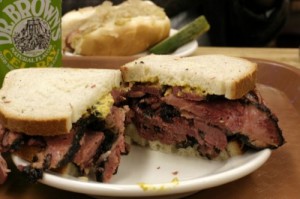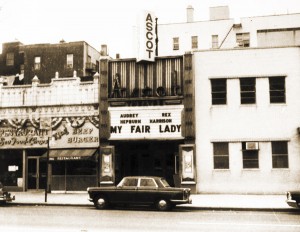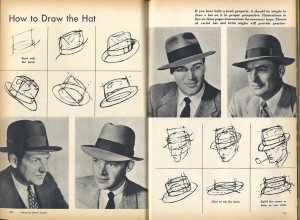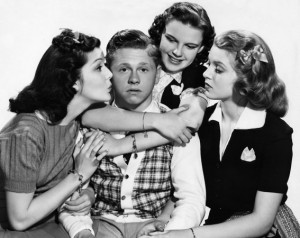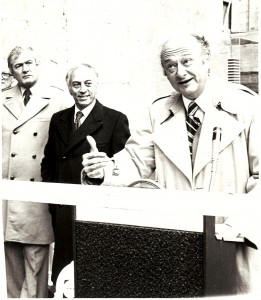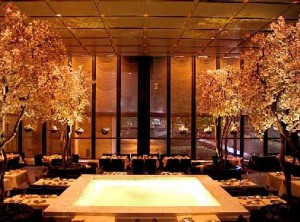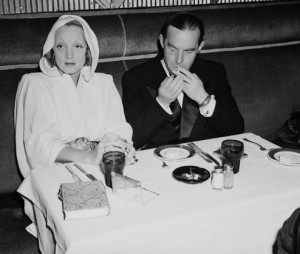The younger generation is disbelieving when HG mentions how cheap New York living used to be. In the 1950’s a quite liveable one room apartment in Greenwich Village or Chelsea rented for $35-45 a month. In the 40’s, a pastrami sandwich was 15 cents (later raised to 17 cents as wartime inflation took hold). The subway was a nickel and there were ferocious protests when the fare was raised to a dime. (Yes..everything is comparable and salaries were low then and inflation has risen…but still…New York was then an affordable, working and middle class city; now it is a city built for the rich with everyone else struggling to stay afloat). During the 1940’s HG’s beloved late sister Beulah Naomi would take young HG to lunch at Larre’s, a French restaurant on W.56th Street in order to give the young man a taste of European civilization. French was spoken at almost every table as wartime immigrants and high school French teachers paid homage to Francophone culture. This what you got for 50 cents: All the French bread you could eat, of course, plus a small, gratis salad. An hors d’oeuvre cart passed through carrying modest treats like lentils, shaved carrots, string beans. Soup (onion or consomme). A long simmered stew with a fancy French name (either beef or mature fowl). Dessert (usually custard described as “Creme Caramel”). Coffee. No, it was not Henri Soule caliber French food but it was okay. Beulah Naomi and HG didn’t know that during World War Two, Larre’s was the favorite restaurant of a group of artists. Robert Motherwell (then interested in surrealism) and other avant-garde visionaries would lunch at Larre’s twice a week with famed French surrealists displaced by the war — among them Marcel Duchamp and Andre Breton. After lunch, the group would stroll to Third Avenue, then filled with antique and second-hand furniture shops. They would browse these shops trying to determine which objects were “surrealistic.” Duchamp (who gave the world the first “ready-made” piece of art i.e. a hanging urinal) was the final arbiter.
Cheap New York & The Surrealists
March 20th, 2013 § 4 comments § permalink
Dr. Brown’s Cel-Ray Tonic – The Big Exception
March 16th, 2013 § 2 comments § permalink
HG loathes all of the popular, incessantly advertised, heavily sugared, artificially sweetened and chemically infused carbonated beverages. Coke, Pepsi, Sprite, Dr. Pepper, etc. To HG they seem to be part of a health destroying plot against the American people. Principals in the plot are the evil profiteers who stock the supermarket shelves with these nasty drinks and their collaborators, the “snack” manufacturers. (Recently they have been joined by the brewers of the “energy” drinks — a la Red Bull). HG looks with dismay as women, accompanied by children, wheel their supermarket carts laden with these vile objects. Do they hate their kids? Have they been brainwashed by television hucksters? In the interests of full disclosure and intellectual honesty, HG must admit to a twice-a-year fall from grace. That’s when HG eats a traditional overstuffed Jewish pastrami sandwich in New York (at Katz’s or Carnegie Deli). What Sauterne is to foie gras and Burgandy is to steak — that’s what Dr. Brown’s Cel-Ray Tonic is to pastrami. The companion made in heaven. Of course, Cel-Ray reeks of fraud. It’s flavored with some kind of celery seed extract — not nice, fresh, healthy celery. It certainly isn’t a tonic. (Okay, okay. At some point the FDA made the manufacturers stop calling it a tonic and label it as “Soda.”) And, HG suspects Dr. Brown’s medical school credentials. Nevertheless, when eating pastrami the drink seems to be just what the doctor ordered — the pungent, almost peppery flavor is the perfect foil for the juicy fat of perfect pastrami. It is a very Jewish beverage and only found where Jews abound — New York and South Florida. You can also find it in such Los Angeles heartburn heavens as Langer’s, Canter’s and Nate and Al’s. Cel-Ray had its birth in Brooklyn in 1868 and for generations was known as “Jewish Champagne.” Pass the pickles and sour tomatoes, please.
Noshing Through Noir At The Ascot
March 7th, 2013 § 0 comments § permalink
At 13 years of age HG was a busy little guy. Following after- school punchball or association football, HG would cruise Kingsbridge Road in the Bronx and help the shopping women. “Carry your bundle, Lady?” said endearing HG and this meant trudging, while heavily laden with shopping bags, up five stories of an apartment house for a nickel or dime tip. A parental allowance was beneath HG’s dignity. HG had to hustle in order to indulge in HG’s Saturday afternoon aesthetic and culinary treat. This was the double feature at the tiny Ascot Theater on the Grand Concourse. HG would pick up some chunks of dry, garlic salami (“a nickel a shtickel”) at the Tower Delicatessen plus two sour dill pickles at a neighboring “appetizing” store (these pickles were plucked fresh from a barrel). Armed with food and a pack of war-time Rameses cigarettes (yes, HG was a smoker even then, a habit he cultivated for some 50 years), HG lounged (and nibbled and smoked) in a balcony seat and succumbed to the joys of European cinema. The Ascot played only art films, mostly French and Russian (and the occasional American film like John Ford’s The Informer.) HG was enthralled by the French “noir” movies starring Jean Gabin (Port of Shadows, La Bete Humaine). Gabin was HG’s favorite movie hero and HG was gratified to learn that Gabin, during World War Two, left a brief Hollywood career (and a blazing romance with Marlene Dietrich) to join the Free French army and fight with the Allies in North Africa. He won the Medaille Militaire and Croix de Guerre and was part of the first contingent to enter liberated Paris. HG’s two favorite films that he watched at the Ascot were Le Grande Illusion (directed by Jean Renoir and starring Gabin) and aforementioned The Informer (starring Victor McLaglen playing “Gypo Nolan.”). HG still recalls Gypo’s last words in the film: “Frankie, your mother forgives me!!”
Years later the Ascot stopped showing art films and devolved into a house of pornography which did not last for long. At last glance the glamorous Ascot was subdivided into a variety of retail spaces while retaining vestiges of its lovely terra cotta facade. In 1988 the writer Avery Corman wrote a nice piece about this stretch of Grand Concourse for the New York Times. It is still relevant today.
Hats and Girdles
March 6th, 2013 § 3 comments § permalink
When HG was growing up, men wore hats. Fedoras for the most part and Homburgs for the rich old guys. There was a switch to Panamas (real and faux) during the summer. Some dudes wore straw hats (known as skimmers or katies.) Among kids there was a New York City legend that you could knock, with impunity, a straw hat right off a man’s head if it was worn after Labor Day. (HG Never saw it happen). And, women wore girdles, thus creating the anatomic oddity — uni-buttocks. Only very racy damsels jettisoned girdles for garter belts. (This was HG’s experience. Admittedly, a quite limited experience but not for want of effort.)
It seems men’s hats are making a modest comeback. SJ, always in style, has been seen sporting an attractive fedora. Girdles, fortunately, are at one with the corset and the buggy whip. Gone forever. Cocktails seemed to be disappearing a few years ago in favor of wimpy glasses of white wine or even wimpier glasses of mineral water. Now, hip diners all over the country are demanding creative pre-dinner libations. And, they seem to be willing to pay the price. Are women still cocktail addicts? They were in HG’s young manhood (there were even cocktail dresses designed specifically for the Happy Hour). Many times HG happily observed suburban ladies in Sardi’s knocking off two (or even three) Manhattans or Martinis during a pre-theater matinee lunch. And, they could meet the challenge of alcohol. Lots of smiles. Lots of laughs. But, definitely not blotto. Which was more than HG could say about the Martini swigging macho guys falling off stools at Sardi’s bar.
Hooray! Red Hook Fairway Re-Opens!
March 1st, 2013 § 0 comments § permalink
Joy. Happiness. Jollity. Yes, life is one big smile today. HG has just learned that the vast Fairway Supermarket located on Brooklyn’s Red Hook waterfront has reopened today. It was so devastated by Hurricane Sandy that few thought it would ever reopen. But, it’s back. Better than ever (with slightly wider aisles). There are those who do not have the advantage, like HG and BSK, of having a son (SJ) and a daughter-in-law (Exquisite Maiko), living close to this cornucopia of good food. So, permit HG to explain. Fairway is the essence of New York City. It is a true family business that began in the Upper West Side as a humble fruit and vegetable market. It has since expanded into multiple locations and boasts huge selections of fish, meat, produce, vegetables and a simply encyclopedic cheese department. But, it is not size or quantity that gives Fairway its character, it is the devotion to sourcing great edibles from Alsatian Sauerkraut to Pickdew Peppers and the passion to actually want to share these great things with their customers in an affordable way that defines the Fairway experience. As such, Fairway caters to a public of every ethnicity, age and economic status. All know food, are infinitely demanding and want the best. There are other Fairways (in Manhattan and on Long Island). But, the Red Hook outpost is the best. Its views of the Statue of Liberty and New York Harbor are incomparable. Eating a Fairway Lobster Roll at one of their outdoor tables with a harbor view is one of the great democratic, affordable food experiences. Then there’s the crowd that fills the store. Remember, you’re in Brooklyn. So, there’s every shade of skin, every manner of dress, every accent. Maybe the best show in town. Yes, New York is indomitable. Whatever happens New York survives, rebuilds, renews and becomes more varied (and expensive!!) than ever. Civil War draft riots? Boss Tweed and Tammany corruption? Quasi-bankruptcy? Nine/Eleven? Hurricane Sandy? Fuhgeddabout it!!! Let’s eat.
Mitchell, McNulty (and SJ)
February 14th, 2013 § 0 comments § permalink
In the most recent New Yorker Magazine, there is a beautiful, heartbreaking piece by the late Joseph Mitchell (1908-1996) entitled: “Street Life: Becoming Part of the City.” In a brief introduction, the New Yorker states: “What follows here is the initial chapter of a planned memoir that Mitchell started in the late sixties and early seventies but, as with other writings after 1964, never completed.” From 1964 to 1996, Mitchell went to his New Yorker office every day but never published a word. Street Life proves once more that nobody wrote about New York City, its places and people, with Mitchell’s eloquence, grace and sensitivity. It is heartbreaking for lovers of the New York City and journalism (a type of journalism that can only be described with the adjectives: literary and poetic) that Mitchell did not publish for 32 years. If you haven’t read Mitchell, check out Amazon for his books (collections of his New Yorker articles). You will be rewarded. Mitchell wrote wonderfully about food — namely seafood (though he did the definitive article on a gluttonous old New York event called a “Beefsteak”). Mitchell loved the Fulton Fish Market, its Sloppy Louie’s Restaurant and its unique raffishness. One of his composite characters, Old Mr. Flood. describes himself as a seafoodetarian. While Mitchell was the Poet Laureate of the Fulton Fish Market, another New Yorker writer, the lamentably short lived John McNulty (1896-1956), was the Poet Laureate of Third Avenue (the Third Avenue which had an El rumbling overhead; the Avenue which was lined with Irish saloons and Jewish pawn shops). Nobody ever wrote better about ordinary New Yorkers, horseplayers, bar room beer drinkers, unsung laborers, office workers, news dealers, etc. James Thurber, his New Yorker colleague, said about him: “Nothing, however commonplace, that he touched remained commonplace, but was magnified and enhanced by his intense and endless fascination.” (Permit justified parental pride. The same words could be applied to SJ and the series of “Sad Chairs” photos and poetic prose SJ posts almost daily on his Sad Chairs Blog. Better than anyone, SJ evokes the bittersweet qualities of urban life. Log into http://sadchairs.tumblr.com/ to experience a very individual view of the city.)
The Alternative Universe of Andy Hardy
February 4th, 2013 § 0 comments § permalink
HG grew up in the Depression era-Bronx. A Jewish-Italian-Irish population. Noisy. Rambunctious. Sporadically violent. HG’s family was immigrant Jewish. The language of HG’s parents was heavily accented English plus Yiddish, patches of Russian and Polish. The family atmosphere was emotionally intense and very noisy. Voices were always raised in order to give communication the proper emphasis. Suffice it to say that it was (despite its many wonderful and much missed qualities) a claustrophobic and insular world. HG’s knowledge of the greater American world was gained from the Andy Hardy movies (Mickey Rooney, Lewis Stone, Kay Holden, Ann Rutherford); the Jack Armstrong-All American Boy serial on radio (sponsored by Wheaties-Breakfast of Champions) and the mystery solving books starring the Hardy Boys. Of the three fictions, HG found greatest comfort in the alternative universe presented by Andy Hardy. Andy lived in a one-family home on a tree lined street in a small town. Not in a stuffy, big city apartment. Andy’s Mother and Father spoke to each other courteously. Andy called his Father: “Sir.” The home atmosphere was quiet, serene. Yes, Andy was sometimes guilty of naughtiness (very minor league, in HG’s opinion). When that happened there was no screaming or hitting. Instead, Andy’s father, Judge Hardy, said, in a low, stern voice: “See me in my study, young man.” Study. What a magic, resonant word. It carried connotations of great civilization that was sorely lacking in HG’s Bronx world. HG vowed that there would be a study in HG’s future. And, so it would come to pass. HG is writing these very words in HG’s study in HG’s quiet and serene New Mexico home. Damn. HG is living in a movie.
Hizzoner R.I.P.
February 2nd, 2013 § 0 comments § permalink
So, Ed Koch is gone. HG will miss him. Koch was everyone’s annoying, funny, smart, overbearing, (slightly racist) Jewish uncle. A true New York City guy. In his eyes, “Upstate” and “out of town” resembled Uzbekistan or Mongolia — strange people and bad food. Ed was very much part of HG and BSK’s New York life. BSK remembers often shaking hands with him (and Bella Abzug, that wonderful feminist in a big hat) when they were campaigning at the W.79th and Broadway subway entrance. During HG’s years as a public relations counselor to New York’s big time real estate developers, HG introduced Ed at numerous groundbreakings, building openings and other pseudo-events. Ed’s remarks were always funny, apt and (thankfully) brief. HG recalled that when Ed spoke at the opening of the revamped Commodore Hotel (HG handled the publicity for this early Donald Trump venture) Koch managed to damn The Egocentric Hairdo with some very faint praise. Most of all, HG thinks about “Hizzoner, the Mayor,” in connection with Chinese food. HG and BSK often would see Koch at their favorite Chinatown restaurant, Phoenix Garden (then located in the arcade between Bowery and Elizabeth). Salt and pepper shrimp, roast squab and many other dishes were outstanding. The Mayor’s favorite was the oddly named (but delicious) “Crab in White Milk Sauce.” (SJ, an agile handler of chopsticks, was tutored in this skill by older Chinese customers at this restaurant). HG handled public relations for the developers and managers of Confucius Plaza, the huge middle-income co-op that dominates Chinatown’s Chatham Square. Because of this, HG was always a guest at the lavish, multi course banquets hosted by the Chinatown business community. HG recalls Koch’s remarks at one banquet: “Sorry I have to leave for another engagement. Usually, when I say that I don’t mean it. I’m glad to leave. Now, I’m leaving with tears in my eyes. I’m leaving when I’m only half way through this magnificent feast. I’m going to Queens to eat some lousy fruit cup.” As he left, he looked sadly and longingly at the platters of sauteed prawns and steamed filets of flounder arriving at the tables. Goodbye, Ed. Olav Hasholem and Rest in Peace.
Putting on the Ritz
February 1st, 2013 § 0 comments § permalink
HG has never enjoyed pricey, upscale, high cuisine restaurants. In many decades of dining, only four have given HG pleasure commensurate with the expenditure. One, Le Pavillon, in New York is long gone, but memories of their fillets of smoked eel topped with a horseradish-infused whipped cream will linger on the HG palate forever. Another, the Connaught Hotel Restaurant in London offered the quintessential civilized English dining experience — perfect Dover Sole (de-boned at the table), Stilton and Port to finish (with a cigar service for those who indulged – and HG did just that). Alas, the Connaught has changed so much that it is unrecognizable. Two, both in New York, are alive and well. One is Le Bernardin and the other is the Four Seasons Restaurant in the Seagram Building. Le Bernardin is flawless, simply the best seafood in the world prepared with flair and imagination. Fabulous wine list supervised by a renowned sommelier. Very, very expensive but not insane. Lunch Prix Fixe is $72 (three courses) and Dinner Prix Fixe is $127 (four courses). Tasting menu is more extravagant — $237 with paired wines. HG was a frequent diner at the Four Seasons during HG’s New York career. The Pool Room is the most beautiful restaurant space in the world. Curiously, New York big shots never ate there. They chose the more austere Grill Room. Menu is the same in both rooms. The Four Seasons used to be expensive but affordable for tax deductible meals. Now, the prices have gone through the roof. An appetizer of Spaghetti with Poached Egg and Black Truffles is $75. Grilled shrimp appetizer is $38. Venison, lamb chops, bison and steak are about $75. If you want to sample Four Seasons cuisine without going broke, take a seat at the bar. The Bar Menu is delicious and affordable (comparatively).
The Original Blue Ribbon
January 29th, 2013 § 14 comments § permalink
The Blue Ribbon was a German restaurant located in New York on W. 44th Street between Sixth and Seventh Avenues. (Don’t confuse it with the cluster of wonderful Blue Ribbon restaurants run by the Bromberg brothers). The original Blue Ribbon opened in 1914 (and managed to survive the World War One anti-German hysteria). Delighted robust eaters for many decades until it closed in 1975. Served all the traditional dishes (kassler ripchen, grilled wursts, wiener schnitzel,sauerbraten, sauerkraut, fried potatoes, etc.). A warm room paneled in dark wood. Comfortable seats and pleasant lighting. A perfect venue for lovers of hearty food washed down with the best of German beers. It was a favorite with Germans who had fled Hitler. (Plus some bad Germans — namely a wartime espionage ring which used the restaurant as a rendezvous before being captured by the FBI). HG dined there very often with journalists from the New York Times. The real estate editor, the late Glenn Fowler, was a frequent dining companion. He introduced HG to steak tartare. Glenn would mix it at the table with a host of ingredients — egg yolks, anchovies, chopped onions, capers, English mustard, Worcestershire sauce, salt, ground pepper and a dash of Tabasco. Very memorable. Best ever. The Blue Ribbon was a short walk from the original Madison Square Garden (50th and 8th Avenue) so it was an HG favorite for a snack after basketball, hockey or fights. HG would choose the apple pancake, a giant affair, at least 18 inches in diameter, oozing sauteed apples enriched with cinnamon, ginger and powdered sugar. Dark beers in chilled mugs within reach, HG and buddies argued about the athletic events. A frequent Blue Ribbon customer was Erich Maria Remarque. His novel, All Quiet On The Western Front, was one of the first books burned by the Nazis. He manged to avoid their clutches by escaping to Switzerland (his sister, Elfriede Schutz, wasn’t as fortunate — she was beheaded by the Nazis for “defeatism”). There are many mentions of the Blue Ribbon in Remarque’s novel about New York in the 1940’s, Shadows In Paradise. Remarque didn’t spend all his time writing and eating. He had a long affair with Marlene Dietrich and a shorter affair with Hedy Lamarr before marrying the beautiful actress, Paulette Goddard. Remarque’s name lives on in New York. Goddard gave New York University $20,000,000 to found the Remarque Institute of European Studies. Permit HG a digression. The first director of the Institute was the late Tony Judt. In HG’s opinion, Judt is the greatest historian of post-World War Two Europe. He was an engaged intellectual who wrote many penetrating studies of world affairs. If you want to have some understanding of the difficult world we live in, you must read his books.

